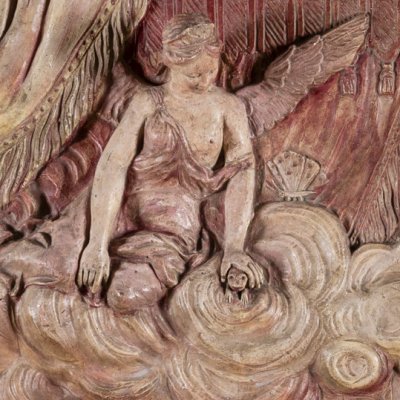Love and Psyche - Thomas Bernus
Description
In the lower section, Amour, recognizable by the bow and quiver laid beside his bed, lies asleep. Above him, Psyche, standing behind the bed, shines an oil lamp on her husband's body, despite his prohibition. Indeed, Psyche's jealous sisters have instilled doubt in the young girl's mind: isn't the husband who visits her every night in the dark a monster? Let her make sure who he is while she sleeps, and take a dagger with her to, if necessary, kill the monster.
The moment in the scene is when Psyche, illuminating her husband's body, is dazzled by the beauty of sleeping Amour. The dazzle is represented by the ray of light coming from the right, cast by another Cupid standing on a globe (Amour rules the world). Psyche lets go of the dagger and drops a drop of flaming oil, not on Amour's shoulder, as Apuleius writes, but on his thigh, as is the iconographic tradition, which thus underlines the eroticism of the scene.
Also on the right, the temple of Venus is depicted, in the shape of a rotunda, and its statue. In the sky, a moon indicates that the scene is nocturnal.
At the top is depicted Psyche divinized, with at her side, the butterfly of the soul, her attribute, and a frog, Egyptian symbol of resurrection. The detail of the frog suggests a later date for the work: the Egyptian campaign, the discovery of the Rosetta Stone in 1799, and the subsequent work to decipher Egyptian, brought late Egyptian antiquity back into the limelight, as did Apuleius' world of reference. Many frog-lamps can be found in Roman Egyptian tombs.
To the right of Psyche, on the inner wall of the chamber, is a kind of altar before which two winged putti are prostrate, adoring an effigy of Cupid inscribed in a circle. These could be the invisible genii of Cupid's palace, who serve Psyche by day.
- Signed lower left "Bernus inv. | sculpsit | et pin"
- Supposedly from a house on Place des Pénitents Noirs in Carpentras. Acquired by the town for the museum in 1843.
Technical Data
Notice #025181


